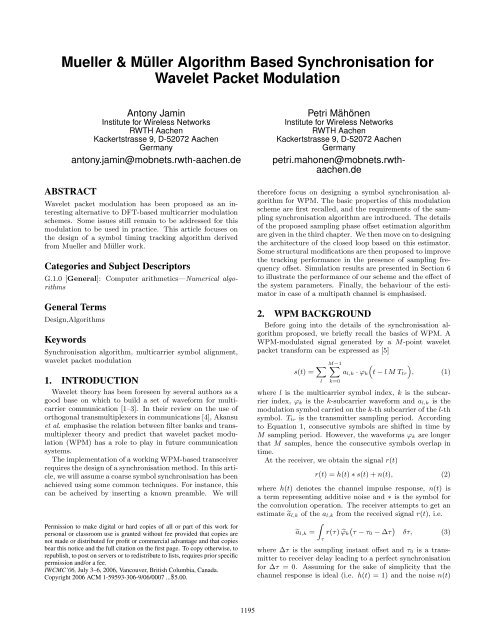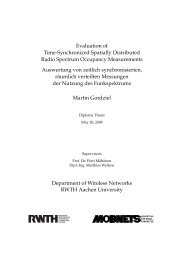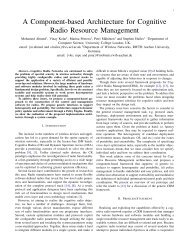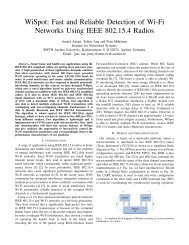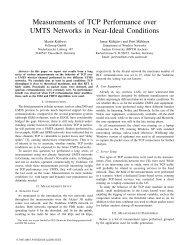Mueller and Muller algorithm based synchronisation for ... - iNETS
Mueller and Muller algorithm based synchronisation for ... - iNETS
Mueller and Muller algorithm based synchronisation for ... - iNETS
Create successful ePaper yourself
Turn your PDF publications into a flip-book with our unique Google optimized e-Paper software.
<strong>Mueller</strong> & Müller Algorithm Based Synchronisation <strong>for</strong><br />
Wavelet Packet Modulation<br />
Antony Jamin<br />
Institute <strong>for</strong> Wireless Networks<br />
RWTH Aachen<br />
Kackertstrasse 9, D-52072 Aachen<br />
Germany<br />
antony.jamin@mobnets.rwth-aachen.de<br />
ABSTRACT<br />
Wavelet packet modulation has been proposed as an interesting<br />
alternative to DFT-<strong>based</strong> multicarrier modulation<br />
schemes. Some issues still remain to be addressed <strong>for</strong> this<br />
modulation to be used in practice. This article focuses on<br />
the design of a symbol timing tracking <strong>algorithm</strong> derived<br />
from <strong>Mueller</strong> <strong>and</strong> Müller work.<br />
Categories <strong>and</strong> Subject Descriptors<br />
G.1.0 [General]: Computer arithmetics—Numerical <strong>algorithm</strong>s<br />
General Terms<br />
Design,Algorithms<br />
Keywords<br />
Synchronisation <strong>algorithm</strong>, multicarrier symbol alignment,<br />
wavelet packet modulation<br />
1. INTRODUCTION<br />
Wavelet theory has been <strong>for</strong>eseen by several authors as a<br />
good base on which to build a set of wave<strong>for</strong>m <strong>for</strong> multicarrier<br />
communication [1–3]. In their review on the use of<br />
orthogonal transmultiplexers in communications [4], Akansu<br />
et al. emphasise the relation between filter banks <strong>and</strong> transmultiplexer<br />
theory <strong>and</strong> predict that wavelet packet modulation<br />
(WPM) has a role to play in future communication<br />
systems.<br />
The implementation of a working WPM-<strong>based</strong> transceiver<br />
requires the design of a <strong>synchronisation</strong> method. In this article,<br />
we will assume a coarse symbol <strong>synchronisation</strong> has been<br />
achieved using some common techniques. For instance, this<br />
can be acheived by inserting a known preamble. We will<br />
Permission to make digital or hard copies of all or part of this work <strong>for</strong><br />
personal or classroom use is granted without fee provided that copies are<br />
not made or distributed <strong>for</strong> profit or commercial advantage <strong>and</strong> that copies<br />
bear this notice <strong>and</strong> the full citation on the first page. To copy otherwise, to<br />
republish, to post on servers or to redistribute to lists, requires prior specific<br />
permission <strong>and</strong>/or a fee.<br />
IWCMC’06, July 3–6, 2006, Vancouver, British Columbia, Canada.<br />
Copyright 2006 ACM 1-59593-306-9/06/0007 ...$5.00.<br />
Petri Mähönen<br />
Institute <strong>for</strong> Wireless Networks<br />
RWTH Aachen<br />
Kackertstrasse 9, D-52072 Aachen<br />
Germany<br />
petri.mahonen@mobnets.rwthaachen.de<br />
there<strong>for</strong>e focus on designing a symbol <strong>synchronisation</strong> <strong>algorithm</strong><br />
<strong>for</strong> WPM. The basic properties of this modulation<br />
scheme are first recalled, <strong>and</strong> the requirements of the sampling<br />
<strong>synchronisation</strong> <strong>algorithm</strong> are introduced. The details<br />
of the proposed sampling phase offset estimation <strong>algorithm</strong><br />
are given in the third chapter. We then move on to designing<br />
the architecture of the closed loop <strong>based</strong> on this estimator.<br />
Some structural modifications are then proposed to improve<br />
the tracking per<strong>for</strong>mance in the presence of sampling frequency<br />
offset. Simulation results are presented in Section 6<br />
to illustrate the per<strong>for</strong>mance of our scheme <strong>and</strong> the effect of<br />
the system parameters. Finally, the behaviour of the estimator<br />
in case of a multipath channel is emphasised.<br />
2. WPM BACKGROUND<br />
Be<strong>for</strong>e going into the details of the <strong>synchronisation</strong> <strong>algorithm</strong><br />
proposed, we briefly recall the basics of WPM. A<br />
WPM-modulated signal generated by a M-point wavelet<br />
packet trans<strong>for</strong>m can be expressed as [5]<br />
s(t) = X l<br />
M−1<br />
X<br />
k=0<br />
a l,k · ϕ k<br />
“<br />
t − l M T tr<br />
”, (1)<br />
where l is the multicarrier symbol index, k is the subcarrier<br />
index, ϕ k is the k-subcarrier wave<strong>for</strong>m <strong>and</strong> a l,k is the<br />
modulation symbol carried on the k-th subcarrier of the l-th<br />
symbol. T tr is the transmitter sampling period. According<br />
to Equation 1, consecutive symbols are shifted in time by<br />
M sampling period. However, the wave<strong>for</strong>ms ϕ k are longer<br />
that M samples, hence the consecutive symbols overlap in<br />
time.<br />
At the receiver, we obtain the signal r(t)<br />
r(t) = h(t) ∗ s(t) + n(t), (2)<br />
where h(t) denotes the channel impulse response, n(t) is<br />
a term representing additive noise <strong>and</strong> ∗ is the symbol <strong>for</strong><br />
the convolution operation. The receiver attempts to get an<br />
estimate ea l,k of the a l,k from the received signal r(t), i.e.<br />
Z<br />
ea l,k = r(τ) bϕ k`τ − τ0 − ∆τ´<br />
δτ, (3)<br />
τ<br />
where ∆τ is the sampling instant offset <strong>and</strong> τ 0 is a transmitter<br />
to receiver delay leading to a perfect <strong>synchronisation</strong><br />
<strong>for</strong> ∆τ = 0. Assuming <strong>for</strong> the sake of simplicity that the<br />
channel response is ideal (i.e. h(t) = 1) <strong>and</strong> the noise n(t)<br />
1195
Timing offsete estimate<br />
1<br />
0.5<br />
0<br />
−0.5<br />
−1<br />
0<br />
5<br />
Subcarrier index<br />
10<br />
15 −1<br />
−0.5<br />
0<br />
0.5<br />
1<br />
Relative timing offset<br />
Figure 1: Estimate of timing offset estimate versus<br />
actual timing offset <strong>for</strong> all subcarriers of a 16-point<br />
WPM trans<strong>for</strong>m WPM signal using Daubechies order<br />
6 wavelet.<br />
is additive white Gaussian, we can rewrite (3) simply as<br />
ea l,k = a l,k · Ψ k (∆τ)<br />
+<br />
M−1<br />
X<br />
k ′ =0, k ′ ≠k<br />
+ X l ′ ≠l<br />
M−1<br />
X<br />
k ′ =0<br />
a l,k ′ · Φ l,l<br />
k ′ ,k (∆τ)<br />
a l ′ ,k ′ · Φl′ ,l<br />
k ′ ,k (∆τ) + n′ k,l, (4)<br />
where Ψ l k(∆τ) <strong>and</strong> Φ l 1,l 2<br />
k 1 ,k 2<br />
(∆τ) are the auto- <strong>and</strong> cross-wave<strong>for</strong>m<br />
detector output values at the erroneous sampling offset ∆τ,<br />
i.e.<br />
Ψ k (τ) =<br />
Φ l 1,l 2<br />
k 1 ,k 2<br />
(τ) =<br />
Z +∞<br />
−∞<br />
Z +∞<br />
−∞<br />
ϕ l k(t) bϕ l k(t − τ) dt (5)<br />
ϕ l 1<br />
k1<br />
(t) bϕ l 2<br />
k2<br />
(t − τ) dt. (6)<br />
The first three terms of Equation (4) correspond to three<br />
distinct types of interference. There is first a biasing factor<br />
in the estimate of the symbol of interest a l,k . In a complete<br />
system, this bias in the estimate is likely to be compensated<br />
by the automatic gain control. The second <strong>and</strong><br />
third terms are inter-carrier interference <strong>and</strong> inter-symbol<br />
inter-carrier interference contributions respectively. Since<br />
WPM is an overlapping modulation scheme, this last term<br />
involves a number of multicarrier symbols. This differs from<br />
non-overlapping schemes such as OFDM since <strong>for</strong> them the<br />
erroneous sampling instant causes inter-symbols interference<br />
only with one adjacent symbol. Finally, n ′ k,l is the additive<br />
noise filtered by the subcarrier wave<strong>for</strong>m ϕ l k.<br />
3. SAMPLING PHASE OFFSET<br />
ESTIMATION<br />
The symbol timing offset estimator is a critical element of<br />
timing tracking loop. Since the possible applications <strong>for</strong>eseen<br />
<strong>for</strong> the WPM are portable, highly flexible, wireless devices,<br />
we must be able to synchronise at low signal-to-noise<br />
ratio (SNR). In addition, it would be interesting if it was capable<br />
of tolerating relatively large clock drifts, as that would<br />
allow the use of very low cost crystal oscillators.<br />
The requirement of a low working SNR restricts the choice<br />
of the estimation <strong>algorithm</strong> since many exhibit a threshold<br />
in the range of 5 to 10 dB, under which the estimator<br />
variance is too high to lead to a reliable <strong>synchronisation</strong>.<br />
The <strong>Mueller</strong> <strong>and</strong> Müller <strong>algorithm</strong> [6], originally introduced<br />
<strong>for</strong> single carrier modulation, does not present such a minimal<br />
SNR threshold <strong>and</strong> it has a very low implementation<br />
complexity. As many <strong>algorithm</strong>s in estimation theory, it is<br />
derived from the maximum likelihood function. The simplest<br />
approximation of the <strong>algorithm</strong> makes use of only two<br />
consecutive estimates ˜b[l − 1], ˜b[l] <strong>and</strong> their corresponding<br />
symbols after the decision ˆb[l − 1], ˆb[l], i.e.<br />
˜θ MM [l] = ˜b[l − 1] ˆb[l] − ˜b[l] ˆb[l − 1] , (7)<br />
where ˜θ MM is the estimate of the sampling phase error.<br />
Equation (7), using the decision symbols ˆb, belongs to the<br />
family of decision directed <strong>algorithm</strong>s [7, Section 6-2-4]. Of<br />
course, known data sequences can be used instead of the decision<br />
symbols. This is of particular interest since not having<br />
decision errors leads to better per<strong>for</strong>mance especially at low<br />
SNR. From a practical point of view, this is rather easy<br />
to setup with multicarrier schemes as it is common to have<br />
some pilot subcarriers modulated with known data symbols.<br />
Since the <strong>Mueller</strong> <strong>and</strong> Müller <strong>algorithm</strong> has been designed<br />
<strong>for</strong> single carrier modulation, its adaptation to the WPM<br />
scheme requires further attention. Louveau et al. have actually<br />
adapted it to the cosine modulated filter bank (CMFB)<br />
modulation [8], an alternative overlapping multicarrier modulation.<br />
It is however noticeable that their derivation, despite<br />
the fact that it is <strong>based</strong> on empirical analysis, is also<br />
valid <strong>for</strong> other multicarrier schemes, including WPM. Independently<br />
of the scheme actually considered, a number of<br />
differences with the single carrier case must be emphasised.<br />
In multicarrier systems, the modulated symbols are only<br />
available at the trans<strong>for</strong>m output. There<strong>for</strong>e the subcarrier<br />
symbols are only available at every M sampling periods T .<br />
This leads to a loop delay that is much higher than with<br />
typical single carrier scheme, hence limiting the minimum<br />
convergence time of the close loop system that would use<br />
it. In addition, the subcarriers being by definition centred<br />
on a different sub-b<strong>and</strong> of the overall channel, the sampling<br />
frequency offset estimation must there<strong>for</strong>e be evaluated on<br />
several subcarriers to increase robustness against frequency<br />
selective fading. We must there<strong>for</strong>e choose how to combine<br />
the different estimates. Derivation in [8] has also shown that<br />
the sign of the sampling phase estimate is inverted <strong>for</strong> the<br />
subcarriers with even index 1 . Hence, the estimate on those<br />
subcarriers having even index must be inverted be<strong>for</strong>e com-<br />
1 Subcarriers are index from 0 to M − 1, M being the trans<strong>for</strong>m<br />
size.<br />
Resampler<br />
Resampler<br />
control block<br />
Filter<br />
Wavelet<br />
Packet<br />
Trans<strong>for</strong>m<br />
TOE<br />
Figure 2: Architecture of the whole digital symbol<br />
<strong>synchronisation</strong> system<br />
P/S<br />
1196
z −1<br />
∑<br />
1 Nk −1<br />
N K i=0<br />
z −1 α i<br />
Figure 3: Architecture of the multicarrier timing<br />
offset estimator<br />
bination. Taking all these considerations into account, we<br />
can express the multicarrier sampling offset estimate f ∆τ as<br />
f∆τ[l] = X k∈K<br />
α k · (−1) k+1 · fδτ k [l] , (8)<br />
where K is the subset of the subcarrier indexes used to estimate<br />
the overall timing offset, α k is a real positive weighing<br />
factor of subcarrier k. f δτ k [l] is the timing error estimate on<br />
subcarrier k directly derived from Equation 7 which can be<br />
rewritten here as a function of the multicarrier symbols as<br />
fδτ k [l] = ã l−1,k · â l,k − ã l,k · â l−1,k . (9)<br />
The introduction of the weighing factor α k raises of course<br />
the question of how the estimates on the different subcarriers<br />
should be combined in order to obtain the final timing<br />
offset estimate. To clarify this particular point, Figure 1<br />
plots the estimates δτ f k [l] of a WPM modulated signal as a<br />
function of the actual frequency offset δτ <strong>for</strong> each subcarrier.<br />
This particular case makes use of a 16-point trans<strong>for</strong>m<br />
of the Daubechies order 4 wavelet. It must be noted that,<br />
as discussed in details in [5], the subcarriers have been reordered<br />
in such a way that the higher the index k is, the<br />
higher the subcarrier centre frequency is. This is important<br />
as it clearly emphasises that the slope of the curve <strong>and</strong> its<br />
validity range are related to the position of the centre frequency<br />
of the subcarrier. In other words, the subcarriers<br />
of lower centre frequency can estimate the timing offset on<br />
a wider range, while the subcarriers with a higher centre<br />
frequency can estimate the timing offset more accurately.<br />
Altogether, this gives us insight in order to decide how to<br />
choose the weighting factors α k . Ultimately, the α k could<br />
be calculated adaptively according to the value of the TOE.<br />
At startup time, the range will be favoured. When the system<br />
has reached a low TOE <strong>and</strong> thus would be in tracking<br />
mode, the accuracy could be given a higher weight in the<br />
overall TOE instead. The approach chosen is intermediate<br />
as the γ k have been chosen in order to have a unity slope<br />
<strong>for</strong> δτ 0.<br />
4. CLOSE LOOP DESIGN<br />
The design of a timing offset estimator (TOE) having been<br />
largely detailed in the last section, a close loop is now required<br />
in order <strong>for</strong> the receiver to acquire <strong>and</strong> track this<br />
timing offset. The technique proposed in this article is well<br />
know as it makes use of a phase locked loop in order to track<br />
the best sampling phase. Its overall architecture is depicted<br />
in Figure 2. Starting from the wavelet packet trans<strong>for</strong>m<br />
output, it is composed of the timing offset estimator, a loop<br />
filter, a resampler control block <strong>and</strong> a resampler.<br />
The architecture of the multicarrier timing offset estimator<br />
is shown in Figure 3. It has been underlined in the previous<br />
section so that the TOE can either be decision driven<br />
or data driven. This has been taken into account in Figure<br />
2 by providing the sampling phase offset estimator with<br />
both the symbols after decision <strong>and</strong> some external reference<br />
symbols.<br />
Following the TOE is the loop filter. It has two functions<br />
in this design. The first is to per<strong>for</strong>m the averaging operation<br />
on the noisy TOE output. The second is linked to<br />
the operation of a phase locked loop: it controls the loop<br />
b<strong>and</strong>width <strong>and</strong> consequently the dynamic response of the<br />
system.<br />
The sampling phase controller is responsible <strong>for</strong> providing<br />
the resampler with the control signals it requires. Namely,<br />
the resampler takes as an input a fractional sampling phase<br />
µ <strong>and</strong> symbol shift indicators. Both signals are generated by<br />
the sampling phase controller <strong>based</strong> on the filtered estimate<br />
of the timing phase offset. The fractional sampling phase is<br />
calculating by integration, i.e.<br />
j<br />
ff<br />
µ[l + 1] = frac µ[l] − Γ phase fστ[l] , (10)<br />
where fστ[l] is ∆τ[l] f after going through the loop filter ,<br />
Γ phase is the phase loop gain <strong>and</strong> the frac{·} returns the<br />
fractional part of its argument. The symbol shift indicator<br />
µ shift [l + 1] is then in charge to provide the resampler with<br />
the additional shift that must be done on its input samples,<br />
i.e.<br />
8<br />
“<br />
>< −1 if<br />
µ shift [l + 1] = +1 if<br />
>:<br />
0 otherwise.<br />
”<br />
µ [ l] − Γ phase · fσ τ [l] ≤ 0,<br />
“<br />
”<br />
µ [ l] − Γ phase · fσ τ [l] > 0,<br />
(11)<br />
The case where µ shift [l] is equal to +1 (resp. −1) corresponds<br />
to the situation where the analog-to-digital converter<br />
is providing samples too slowly (resp. too fast) <strong>and</strong> conse-<br />
Figure 4:<br />
block<br />
ACC.<br />
Γ phase<br />
1<br />
M<br />
Γ period<br />
∆τ<br />
∆T<br />
∑<br />
µ<br />
µ shift<br />
Architecture of the resampler control<br />
1197
Frequency offset [ppm]<br />
Phase error [× π]<br />
Deviation of sampling period around ideal value versus symbol index<br />
2<br />
0<br />
Γ = 2 −8 , Γ = 0<br />
phase period<br />
−2<br />
Γ = 2 −8 , Γ = 2 −16<br />
phase period<br />
−4<br />
−6<br />
−8<br />
−10<br />
−12<br />
−14<br />
−16<br />
0 500 1000 1500 2000 2500 3000 3500 4000<br />
Time [in symbol periods]<br />
0.3<br />
0.2<br />
0.1<br />
0<br />
−0.1<br />
−0.2<br />
Sampling instant relative error versus symbol index<br />
Γ phase<br />
= 2 −8 , Γ period<br />
= 0<br />
Γ phase<br />
= 2 −8 , Γ period<br />
= 2 −16<br />
0 500 1000 1500 2000 2500 3000 3500 4000<br />
Time [in symbol periods]<br />
Figure 5: Algorithm per<strong>for</strong>mance comparison without<br />
<strong>and</strong> with sampling period estimation. The modulation<br />
is 64-point WPM with Daubechies order 6<br />
wavelet. yAll the subcarriers are used <strong>for</strong> timing<br />
estimation, <strong>and</strong> the loop gains are Γ phase = 2 −8 <strong>and</strong><br />
Γ period = 2 −16 .<br />
quently one input sample should be skipped (resp. used<br />
twice).<br />
In order to correct <strong>for</strong> the sampling phase offset, a digital<br />
resampler is used. Its architecture is <strong>based</strong> on the Farrow<br />
structure, with 4 interpolation polynomials of order 3. This<br />
corresponds to the case M = 3, N = 2 described in details<br />
in [9, Section 9.1.3]. Since it is rather difficult to design<br />
a resampler with a flat response over the whole frequency<br />
b<strong>and</strong>, the signal interpolated is actually sampled at R the<br />
modulation Nyquist rate. This looses the requirements on<br />
the resampler as its frequency domain response need only<br />
to be flat <strong>for</strong> the normalized frequencies between 0 <strong>and</strong> in a<br />
2πω<br />
. R<br />
5. TRACKING PERFORMANCE<br />
IMPROVEMENT<br />
The system described so far is capable of locking accurately<br />
on the correct sampling phase when the sampling frequency<br />
offset is small enough. In the case of higher sampling<br />
period offset, the delay of the tracking loop prevents the<br />
loop from reaching a steady state, resulting in the sampling<br />
offset estimate to be bias. This is easily underst<strong>and</strong>able<br />
since the loop attempts to lock on a sampling phase which<br />
is constantly drifting. The actual sampling phase is there<strong>for</strong>e<br />
lagging behind the ideal sampling phase. The remaining<br />
sampling phase error is then in proportion to the sampling<br />
period offset, the loop total delay <strong>and</strong> the loop gain. In most<br />
applications, this constant sampling phase error is not acceptable<br />
as it results in a significant signal distortion, hence<br />
limiting the highest SNIR achievable by the system.<br />
A simple way of compensating <strong>for</strong> the sampling period<br />
offset, is to use its estimate ∆T g in the calculation of the<br />
ideal sampling instant ˆµ[l], i.e.<br />
ff<br />
µ[l + 1] = frac<br />
jµ[l] − Γ phase ∆τ[l] f − Γperiod ∆T g [l] , (12)<br />
where Γ period is the sampling period loop gain. Of course,<br />
this now leads to the problem of calculating ∆T g . By observing<br />
the sampling phase offset is equal to the integral of<br />
the period offset, we can write:<br />
Xl−1<br />
g∆T [l] = fστ[j]. (13)<br />
j=0<br />
Figure 4 shows the simplified architecture of the resulting<br />
resampler control block. The addition of the 1 is necessary<br />
M<br />
because the TOE are provided every M clock periods. In<br />
practice, this constant is merged together with the loop gain.<br />
In system control theory, this modification of the loop is<br />
equivalent to adding an integral branch to the system, while<br />
the phase correction corresponds to the proportional branch.<br />
6. SIMULATION RESULTS<br />
This section reports some simulation results in order to<br />
illustrate the behaviour of our sampling phase tracking <strong>algorithm</strong>.<br />
Figure 5 shows <strong>for</strong> instance the difference in per<strong>for</strong>mance<br />
when estimating the sampling frequency in addition to the<br />
sampling phase. The modulation used is making use of<br />
Daubechies order 6 wavelet with 64 subcarriers, all used as<br />
reference pilots <strong>for</strong> the purpose of illustration. The period<br />
offset <strong>and</strong> SNR are set to 10 ppm <strong>and</strong> 30 dB respectively.<br />
For the case with sampling phase estimate only, Γ phase is set<br />
equal to 2 −8 while <strong>for</strong> the sampling frequency <strong>and</strong> phase estimate<br />
case, Γ phase <strong>and</strong> Γ freq are set equal to 2 −8 <strong>and</strong> 2 −16<br />
respectively. The estimated sampling period offset versus<br />
the multicarrier symbol index is shown in the upper plot.<br />
For the case without period estimation, the estimate of the<br />
error is of course plotted as constant <strong>and</strong> null. For the other<br />
case, the estimate of the period offset converges towards the<br />
ideal value of −10 ppm. The lower plot displays the corresponding<br />
sampling phase error. While the first scenario<br />
leads to a constant phase offset, the second one is capable of<br />
tracking the sampling phase offset, hence leading to a null<br />
sampling phase offset.<br />
Figure 6 illustrates the effect of the overall loop delay of<br />
the tracking per<strong>for</strong>mance of the <strong>algorithm</strong>. For comparison<br />
purpose, a system has been simulated with WPM <strong>based</strong> on<br />
Daubechies wavelets of order 4, 6, 8 <strong>and</strong> 10 respectively.<br />
Sampling phase error [× π]<br />
0.3<br />
0.2<br />
0.1<br />
0<br />
−0.1<br />
Sampling instant relative error versus symbol index<br />
−0.2<br />
db4<br />
db6<br />
−0.3<br />
db8<br />
db10<br />
−0.4<br />
0 500 1000 1500 2000 2500 3000<br />
Time [in symbol periods]<br />
Figure 6: Comparison of sampling phase acquisition<br />
time as a function of the wavelet packet length<br />
within the Daubechies family. The modulation is<br />
64-point WPM, the SNR is 20 dB, all the subcarriers<br />
are used <strong>for</strong> timing estimation, <strong>and</strong> the loop<br />
gains are Γ phase = 2 −8 <strong>and</strong> Γ period = 2 −16 . The initial<br />
normalised phase error was set to 0.25.<br />
1198
With the subcarrier wave<strong>for</strong>ms increasing in order, it can<br />
clearly be seen that the system converges to a steady state,<br />
with sensibly different damping factors.<br />
As <strong>synchronisation</strong> procedure usually takes place be<strong>for</strong>e<br />
equalisation, it is important to analyse the behaviour of any<br />
<strong>synchronisation</strong> scheme in the presence of a channel. For the<br />
sake of simplicity, we will assume a simple static frequency<br />
channel with a time domain response h = [0.35 1 0.31 0.07 −<br />
0.04 0.13 0.04 − 0.05]. The upper half of Figure 7 displays<br />
the time <strong>and</strong> frequency responses of this particular channel,<br />
while the corresponding S-curve is plotted in its lower<br />
half. It can be verified the stable point, corresponding to<br />
∆τ ˜ = 0, is slightly offset. By rewriting Equation 4 taking<br />
into account the channel response h(t) <strong>and</strong> ignoring the<br />
interference terms, we obtain<br />
˛ f∆τ[l] = h(t) ∗ ∆τ[l]. ˛multipath f (14)<br />
An easy way to picture the resulting S-curve is to sum up<br />
the time-shifted, weighted version of the ideal channel S-<br />
curve. The shift in time <strong>and</strong> weighing factors corresponds<br />
to the delay <strong>and</strong> amplitude of each tap of the channel impulse<br />
response. It must be noticed that in an actual system,<br />
this offset does not normally cause significant per<strong>for</strong>mance<br />
degradation as it should be compensated by the equaliser.<br />
We have shown that the <strong>algorithm</strong> could work in both<br />
data-aided or direction directed mode. The <strong>for</strong>mer alternative<br />
is obviously most interesting as no b<strong>and</strong>width is lost<br />
in transmission of known symbols. On the other h<strong>and</strong>, in<br />
decision directed mode, any decision errors degrade per<strong>for</strong>mance<br />
of the estimator. This results in increased variance of<br />
the estimates at low SNR since this is the region where the<br />
errors have the highest probability of occurrence. This is<br />
illustrated by Figure 8, where the variance of the estimates<br />
<strong>for</strong> both modes are plotted as a function of the SNR. This<br />
particular simulation uses binary amplitude modulation (2-<br />
PAM) <strong>and</strong> here again the modulation is Daubechie order<br />
6 <strong>based</strong> WPM with weighing factors set <strong>for</strong> unity slope at<br />
origin.<br />
7. CONCLUSION AND FURTHER WORK<br />
We have reported the design <strong>and</strong> per<strong>for</strong>mance of a sam-<br />
Amplitude<br />
Timing offset estimate<br />
1<br />
0.5<br />
0<br />
0.2<br />
0.1<br />
−0.1<br />
−0.2<br />
Channel impulse response<br />
−1 0 1 2 3 4 5 6<br />
Tap relative index<br />
0<br />
Amplitude [dB]<br />
2<br />
0<br />
−2<br />
S−curve <strong>for</strong> the selected subcarriers<br />
Channel frequency response<br />
−4<br />
0 0.1 0.2 0.3 0.4 0.5<br />
Normalized frequency<br />
−0.2 −0.15 −0.1 −0.05 0 0.05 0.1 0.15 0.2<br />
Normalized timing offset<br />
Figure 7: Overall timing offset estimate versus actual<br />
timing offset (S-curve) in presence of a multipath<br />
static channel. The channel impulse <strong>and</strong> frequency<br />
responses are plotted in the upper part. The<br />
system uses a 16-point trans<strong>for</strong>m WPM <strong>based</strong> on<br />
Daubechies order 6 wavelet.<br />
Timing estimate variance<br />
Variance of TOE versus SNR <strong>for</strong> 2 different modes<br />
40<br />
data aided<br />
30<br />
decision directed<br />
20<br />
10<br />
0<br />
−10<br />
−20<br />
−30<br />
−5 0 5 10 15 20<br />
SNR [dB]<br />
Figure 8: Variance of timing offset estimate versus<br />
SNR <strong>for</strong> data-aided <strong>and</strong> decision directed<br />
modes.The system uses a 16-point trans<strong>for</strong>m WPM<br />
<strong>based</strong> on Daubechies order 6 wavelet.<br />
pling phase <strong>and</strong> frequency offset recovery <strong>algorithm</strong> <strong>for</strong> WPM<br />
signals. The technique used has been adapted from some<br />
work carried out <strong>for</strong> CMFB-<strong>based</strong> architecture, another overlapping<br />
modulation scheme. The overall architecture of the<br />
symbol timing tracking <strong>algorithm</strong> has been described, <strong>and</strong><br />
its per<strong>for</strong>mance in various conditions has been reported.<br />
The system has been designed to be capable of working at<br />
low SNR <strong>and</strong> in presence of relatively large clock frequency<br />
offset, making it suitable <strong>for</strong> a wide range of applications.<br />
Further research work remains to be carried out on exploiting<br />
the dyadic tree structure which is specific to WPT<br />
<strong>for</strong> <strong>synchronisation</strong>. In fact, it is likely that making use of<br />
the multi-resolution signals internal to the receiver WPT<br />
will lead to a <strong>synchronisation</strong> method with improved characteristics.<br />
8. REFERENCES<br />
[1] B. G. Negash <strong>and</strong> H. Nikookar, “Wavelet-<strong>based</strong> multicarrier<br />
transmission over multipath wireless channels,” Electronics<br />
Letters, vol. 36, no. 21, pp. 1787–1788, October 2000.<br />
[2] C. J. Mtika <strong>and</strong> R. Nunna, “A wavelet-<strong>based</strong> multicarrier<br />
modulation scheme,” in Proceedings of the 40 th Midwest<br />
Symposium on Circuits <strong>and</strong> Systems, vol. 2, August 1997, pp.<br />
869–872.<br />
[3] G. W. Wornell, “Emerging applications of multirate signal<br />
processing <strong>and</strong> wavelets in digital communications,” in<br />
Proceedings of the IEEE, vol. 84, 1996, pp. 586–603.<br />
[4] A. Akansu, P. Duhamel, X. Lin, <strong>and</strong> M. de Courville,<br />
“Orthogonal transmultiplexers in communications: a review,”<br />
IEEE Transactions on Signal Processing, vol. 46, no. 4, pp.<br />
979–995, April 1998.<br />
[5] A. Jamin <strong>and</strong> P. Mähönen, “Wavelet packet <strong>based</strong> modulation<br />
<strong>for</strong> wireless communications,” Wiley Wireless Communications<br />
<strong>and</strong> Networking Journal, vol. 5, no. 2, pp. 123–137, March 2005.<br />
[6] K. H. <strong>Mueller</strong> <strong>and</strong> M. Müller, “Timing recovery in digital<br />
synchronous data receivers,” IEEE Transactions on<br />
Communications, vol. COM-24, no. 5, pp. 516–531, May 1976.<br />
[7] J. G. Proakis, Digital communications, 3rd ed. Mc Graw Hill<br />
international editions, 1995.<br />
[8] J. Louveaux, L. Cuvelier, L. V<strong>and</strong>endorpe, <strong>and</strong> T. Pollet, “Baud<br />
rate timing recovery scheme <strong>for</strong> filter bank-<strong>based</strong> multicarrier<br />
transmission,” IEEE Transactions on Communications,<br />
vol. 51, no. 4, pp. 652–663, April 2003.<br />
[9] H. Meyr, M. Moeneclaey, <strong>and</strong> S. A. Fechtel, Digital<br />
communication receivers. Wiley Interscience, 1997.<br />
1199


